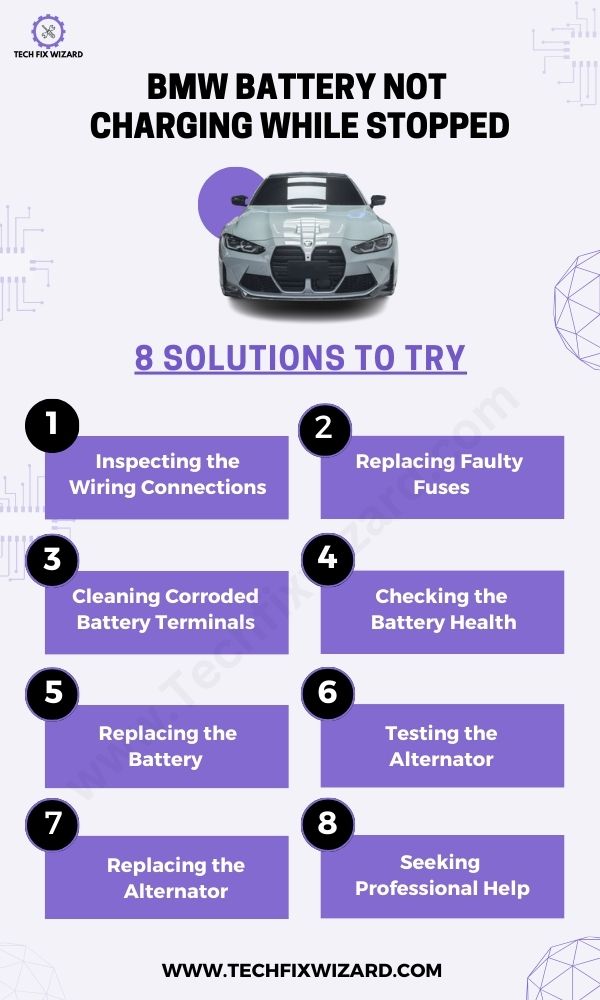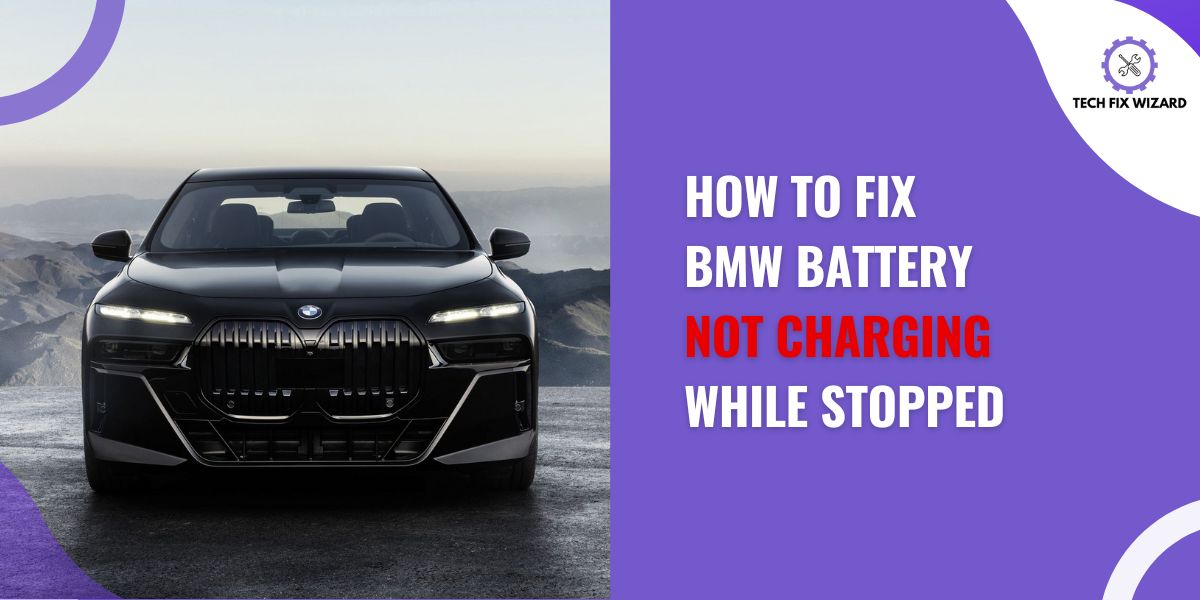Experiencing a BMW battery not charging while stopped can be frustrating and concerning.
When your BMW battery fails to charge while the vehicle is stationary, it can lead to unexpected breakdowns, difficulties starting the car, and overall inconvenience.
In this article, we will explore common reasons behind a BMW battery not charging while stopped and provide you with practical solutions to resolve the problem.
Contents
- 1 Troubleshooting BMW Battery Not Charging While Stopped
- 2 1. Inspecting the Wiring Connections
- 3 2. Replacing Faulty Fuses
- 4 3. Cleaning Corroded Battery Terminals
- 5 4. Checking the Battery Health
- 6 5. Replacing the Battery
- 7 6. Testing the Alternator
- 8 7. Replacing the Alternator
- 9 8. Seeking Professional Assistance
- 10 Preventing Future Charging Issues
- 11 FAQs
- 12 Why is my BMW battery not charging while stopped?
- 13 How can I determine if my alternator is the cause of the problem?
- 14 What should I do if my battery is old and not holding a charge?
- 15 Can a loose or damaged wiring connection cause the battery not to charge?
- 16 Are there any signs or symptoms that indicate a problem with the charging system?
- 17 How often should I have my charging system inspected?
- 18 Can extreme temperatures affect the battery’s charging ability?
- 19 Can using electronic accessories while the engine is off drain the battery?
- 20 Can a faulty fuse cause the battery not to charge?
- 21 Should I try jump-starting my BMW if the battery is not charging?
- 22 Can I charge my BMW battery using an external battery charger?
- 23 When should I seek professional assistance for a BMW battery not charging issue?
- 24 Official References & Resources
Troubleshooting BMW Battery Not Charging While Stopped
Several factors could contribute to this issue, and it’s important to approach troubleshooting systematically.
By following a series of steps given below, you can identify potential causes and find solutions to get your BMW battery charging properly.
Let’s begin the troubleshooting!
1. Inspecting the Wiring Connections
When troubleshooting a BMW battery not charging while stopped issue, one of the first steps is to inspect your wiring connections.
Over time, wiring connections can become loose, corroded, or damaged, affecting the flow of electricity to and from the battery.
By carefully examining the wiring connections, you can identify any potential issues and address them accordingly.
- Open the hood of your BMW and locate the battery.
- Examine the wiring connections attached to the battery terminals for signs of corrosion.
- Check the tightness of the connections to ensure they are securely fastened.
- Inspect the wiring harnesses connected to the alternator and other relevant components for any visible damage.
- Look for frayed or exposed wires that may disrupt the flow of electricity.
- Clean any corroded terminals using a wire brush or specialized cleaning solution.
- Ensure all additional electrical components or accessories connected to the battery or charging system have secure and undamaged connections.

Also Read: BMW Not Charging Battery – 6 Causes & Solutions
2. Replacing Faulty Fuses
A fuse is an important safety device that protects your car’s electrical system from damage caused by excessive current flow.
When a circuit experiences an overload, the fuse breaks the connection, preventing further damage to the system.
Changing a fuse can potentially solve a battery not charging issue if the fuse responsible for the charging circuit has blown or become faulty.
Use the following steps to replace your faulty fuses:
- Locate the fuse box in your BMW. It is typically located in the engine compartment or the interior of the vehicle, depending on the model.
- Refer to your BMW’s owner’s manual or the fuse box cover for the specific location and function of the charging-related fuses.
- Use a fuse puller tool or a pair of needle-nose pliers to carefully remove the faulty fuse from its socket.
- Be cautious not to damage the fuse or surrounding components.
- Inspect the fuse for any signs of damage, such as a blown filament or discolored appearance. If the fuse appears to be faulty, proceed with replacing it.
- Obtain a replacement fuse with the same rating and specifications as the original. It is important to use the correct type and amp rating to ensure proper operation.
- Insert the new fuse into the appropriate socket, making sure it fits securely and is fully seated.
- Double-check that all other fuses in the charging circuit are intact and in good condition.
- Close the fuse box securely.
- Test the charging system by starting the vehicle and monitoring the battery voltage or using a voltmeter to verify the charging status.
Also Read: BMW Battery Not Charging Warning – 6 Troubleshooting Steps
3. Cleaning Corroded Battery Terminals
Now it’s time to check the battery of your BMW. Start by inspecting the battery for any signs of corrosion on the terminals.
Corrosion can occur due to a buildup of acid and other deposits, which can hinder the battery’s performance and affect its ability to charge.
If you notice any white or greenish powdery substance on the battery terminals, it indicates the presence of corrosion.
- Gather necessary materials: gloves, safety glasses, baking soda, water, wire brush or abrasive pad, and a wrench.
- Disconnect the negative cable from the battery.
- Create a paste by mixing a tablespoon of baking soda with water.
- Apply the baking soda paste to the corroded terminals.
- Let the paste sit for several minutes.
- Use a wire brush or abrasive pad to scrub away the corrosion.
- Rinse the terminals with clean water.
- Dry the terminals thoroughly.
- Reconnect the negative cable.
4. Checking the Battery Health
To determine the health of your battery, you should regularly check its voltage and inspect for any signs of damage or corrosion.
Here are three easy steps to follow:
| Steps for Checking Battery Health | Description |
|---|---|
| 1. Check the battery voltage | Use a voltmeter to measure the battery voltage. A healthy battery should have a voltage reading of around 12.6 volts or higher. |
| 2. Conduct a load test | Perform a load test to assess the battery’s ability to deliver power. This test measures the voltage drop when a load is applied.
A significant drop indicates a weak battery. |
| 3. Consider battery age | Take into account the age of the battery. Most automotive batteries last around 3-5 years.
If your battery is approaching or exceeding this range, it may be time for a replacement. |
Also Read: BMW Electric Car Not Charging – 5 Causes & Solutions
5. Replacing the Battery
Following are the steps to follow to replace the battery while troubleshooting the BMW Battery Not Charging While Stopped issue:
| Step | Steps to Replace the Battery in a BMW |
|---|---|
| 1 | Disconnect the negative (black) cable from the battery terminal. |
| 2 | Disconnect the positive (red) cable from the battery terminal. |
| 3 | Remove any brackets or restraints holding the battery in place. |
| 4 | Lift the battery out of the compartment. |
| 5 | Clean the battery tray and terminals. |
| 6 | Install the new battery, making sure it is properly aligned. |
| 7 | Reattach the brackets or restraints to secure the battery in place. |
| 8 | Connect the positive (red) cable to the positive terminal of the new battery. |
| 9 | Connect the negative (black) cable to the negative terminal of the new battery. |
| 10 | Double-check all connections and ensure they are secure. |
| 11 | Start the vehicle to verify that the new battery is working properly. |
| 12 | Dispose of the old battery at a designated recycling center. |
6. Testing the Alternator
Testing the alternator is a crucial step in troubleshooting a BMW battery not charging issue.
The alternator is responsible for generating electrical power and recharging the battery while the engine is running.
If the alternator is not functioning properly, it can lead to a drained battery or insufficient charging.

Here are the steps to perform the alternator test:
- Ensure Safety: Before starting any electrical tests, ensure that the engine is turned off and the ignition key is removed to prevent any accidents.
- Locate the Alternator: The alternator is typically located near the front of the engine, with a belt connecting it to the engine crankshaft pulley.
- Connect the Multimeter: Set the multimeter or voltmeter to the DC voltage setting. Connect the positive (red) lead of the multimeter to the positive terminal of the battery and the negative (black) lead to the negative terminal.
- Start the Engine: Start the engine and let it idle. Observe the voltage reading on the multimeter. Ideally, it should read around 13.5 to 14.5 volts.
- Rev the Engine: While the engine is running, rev it to around 2000 to 3000 RPM and observe the voltage reading on the multimeter. It should remain stable or show a slight increase in voltage.
- Check for Consistency: Repeat the engine revving and voltage reading a few times to ensure consistency in the alternator’s output. Any significant fluctuations or a voltage drop could indicate an issue with the alternator.
- Interpret the Results: Compare the voltage readings with the specifications provided by the manufacturer. If the voltage readings are consistently low or outside the recommended range, it indicates a potential problem with the alternator.
7. Replacing the Alternator
If the alternator itself is malfunctioning or has failed to replace it can be a solution to resolve a battery not charging issue
Here’s an overview of the process of changing the alternator:
1. Gather the Necessary Tools and Parts:
To replace the alternator, you’ll need a set of basic hand tools such as wrenches, sockets, and screwdrivers. Additionally, you’ll need a new alternator specific to your BMW model.
2. Disconnect the Battery:
Begin by disconnecting the negative terminal of the battery to prevent any electrical shocks or accidents during the replacement process.
It’s important to follow proper safety procedures and use protective gloves and eyewear.
3. Locate and Remove the Old Alternator:
The alternator is typically located near the engine and connected to the serpentine belt or drive belt. Refer to your BMW’s service manual or consult a reliable source for the exact location and removal procedure.
Disconnect any electrical connections and remove the mounting bolts or brackets securing the alternator in place.
4. Install the New Alternator:
Take the new alternator and position it in the same location where the old one was removed.
Reattach the mounting bolts or brackets and reconnect any electrical connections, ensuring they are properly secured.
5. Reconnect the Battery:
Once the new alternator is installed, reconnect the negative terminal of the battery. Double-check that all connections are secure and tighten any loosened bolts or fittings.
6. Test the Charging System:
Start the engine and monitor the battery charging status. Use a voltmeter to check the voltage output of the alternator and ensure that the battery is receiving a proper charge.
If the battery is charging and the voltage remains stable, it indicates a successful alternator replacement.
Popular Pick: BMW Hybrid Battery Not Charging – 7 Steps To Follow
8. Seeking Professional Assistance
If you have gone through the troubleshooting steps and still cannot resolve the issue with your BMW’s battery not charging while stopped, it may be time to seek professional assistance.
Consulting a qualified mechanic or contacting your BMW dealership will provide you with access to specialized knowledge and diagnostic equipment to accurately identify and fix the problem.
They can perform in-depth inspections, run diagnostic tests, and provide expert guidance to resolve the battery charging issue effectively.
Remember, professional assistance ensures that the problem is diagnosed and addressed correctly, giving you peace of mind and saving you time and effort.
Preventing Future Charging Issues
To ensure your BMW’s charging system remains reliable, you should regularly maintain the components involved in your car’s electrical system. Here are three ways to prevent future charging issues:
- Keep Battery Terminals Clean: Regularly clean battery terminals to remove dirt and debris that can hinder electrical flow.
- Inspect Alternator Belt: Check for signs of wear or damage on the alternator belt, and ensure it is properly tightened.
- Test Charging System: Use a voltmeter to measure alternator voltage output while the engine is running, looking for consistent readings and avoiding significant voltage drops over time.
By following these tips and staying proactive about maintaining your car’s electrical system, you can help prevent future charging issues and keep your BMW running smoothly for years to come.
FAQs
Why is my BMW battery not charging while stopped?
There could be several reasons for this issue, including a faulty alternator, a worn-out battery, a loose or damaged wiring connection, or a malfunctioning charging system.
How can I determine if my alternator is the cause of the problem?
You can have your alternator tested by a professional using specialized diagnostic equipment. They will be able to assess the charging output of the alternator and determine if it needs to be repaired or replaced.
What should I do if my battery is old and not holding a charge?
If your battery is old and no longer holding a charge effectively, it may be time for a replacement.
Consult your BMW dealership or a qualified mechanic to find the right battery for your vehicle.
Can a loose or damaged wiring connection cause the battery not to charge?
Yes, loose or damaged wiring connections can disrupt the flow of electricity and prevent the battery from charging properly.
Inspect your wiring connections and ensure they are secure and free from damage or corrosion.
Are there any signs or symptoms that indicate a problem with the charging system?
Yes, common signs of a charging system issue include dim or flickering headlights, a warning light on the dashboard, difficulty starting the vehicle, or a battery that frequently needs to be jump-started.
How often should I have my charging system inspected?
It’s a good practice to have your charging system inspected as part of your regular vehicle maintenance routine.
Consult your vehicle’s owner manual or a trusted mechanic to determine the recommended interval.
Can extreme temperatures affect the battery’s charging ability?
Yes, extreme temperatures, both hot and cold, can affect the performance and charging ability of the battery.
In very cold temperatures, the battery may struggle to maintain a charge, while extreme heat can cause the battery to degrade faster.
Can using electronic accessories while the engine is off drain the battery?
Yes, using electronic accessories, such as the radio, lights, or air conditioning, while the engine is off can drain the battery’s charge over time.
It’s advisable to limit the use of these accessories when the engine is not running.
Can a faulty fuse cause the battery not to charge?
Yes, a faulty fuse in the charging system can disrupt the flow of electricity and prevent the battery from charging properly.
Check the fuses related to the charging system and replace any that are damaged or blown.
Should I try jump-starting my BMW if the battery is not charging?
Jump-starting the vehicle may provide temporary power to start the engine, but it will not resolve the underlying charging issue.
It’s important to address the root cause of the problem to ensure a reliable charging system.
Can I charge my BMW battery using an external battery charger?
Yes, if you have access to an external battery charger, you can attempt to charge the battery independently.
However, it’s crucial to identify and fix the underlying charging system issue to prevent further battery drainage.
When should I seek professional assistance for a BMW battery not charging issue?
If you have gone through the troubleshooting steps and are unable to resolve the issue, it’s recommended to seek professional assistance from a qualified mechanic or contact your BMW dealership.
Official References & Resources
To provide accurate and reliable information about BMW, we have extensively utilized official references and resources directly from BMW and its affiliated entities.
Our research and data gathering involved thorough analysis of the official websites, including:

John Paul is a tech enthusiast dedicated to troubleshooting. He is passionate about fixing glitches, simplifying complexities, and empowering others in the digital realm.

